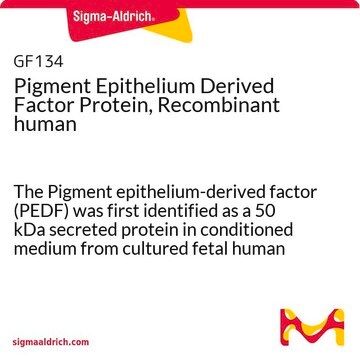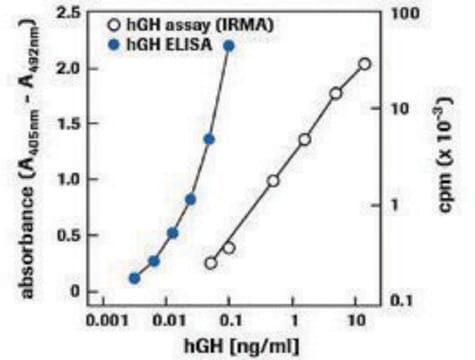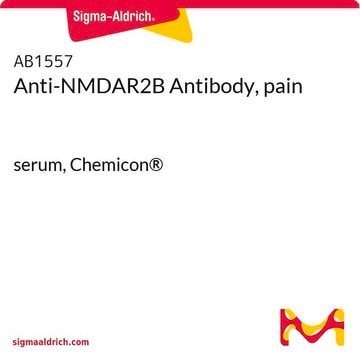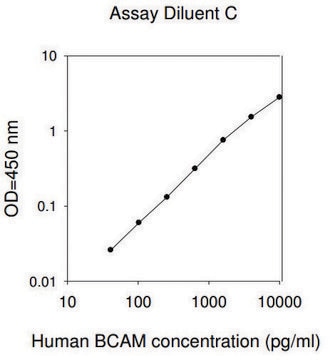推薦產品
product name
ChemiKine Pigment Epithelium Derived Factor, Sandwich ELISA, This ChemiKine Pigment Epithelium Derived Factor, Sandwich ELISA is used to measure & quantify PEDF levels in Neuroscience research.
生物源
mouse
品質等級
無性繁殖
monoclonal
物種活性
human
製造商/商標名
ChemiKine
Chemicon®
技術
ELISA: suitable
NCBI登錄號
UniProt登錄號
應用
research use
檢測方法
colorimetric
運輸包裝
wet ice
一般說明
Introduction
Pigment Epithelium-Derived Factor (PEDF) was first identified as a factor secreted by primary retinal pigment epithelial (RPE) cells that promotes the survival of neurons in vitro and in vivo. Molecular characterization of PEDF shows it to be a 50 kDa member of the serpin family of protease inhibitors1. A second mode of action of PEDF was identified with the demonstration that PEDF induces apoptosis of microvascular endothelial cells, a property that maintains the avascular nature of the retina2. As a number of ophthalmologic disorders are characterized by dysregulation of the retinal innervation and microvasculature, PEDF serves as an important regulator of human eye disease3. In addition, PEDF appears to have multifunctional antitumor activity in a neuroblastoma model, as Schwann cell-derived PEDF induces a differentiated, less malignant phenotype in neuroblastoma cells, promotes further growth and survival of Schwann cells, and inhibits angiogenesis4.
ChemiKine Pigment Epithelium-Derived Factor (PEDF) kit is a sandwich stripwell-type enzyme immunoassay (EIA), which measures PEDF. The kit will measure PEDF of vitreous fluid of human origin.
Test Principle
With the ChemiKine PEDF assay system, a mouse monoclonal antibody generated against human PEDF is coated onto a microplate and is used to capture PEDF from a sample. A second, biotinylated PEDF-specific mouse monoclonal antibody detects the captured PEDF. Peroxidase-labeled streptavidin detects the biotinylated mouse monoclonal antibody. After addition of the substrate and stop solution the amount of PEDF is determined. The standard curve demonstrates a direct relationship between Optical Density (OD) and PEDF concentration: i.e., the higher the OD the higher the PEDF concentration in the sample.
Pigment Epithelium-Derived Factor (PEDF) was first identified as a factor secreted by primary retinal pigment epithelial (RPE) cells that promotes the survival of neurons in vitro and in vivo. Molecular characterization of PEDF shows it to be a 50 kDa member of the serpin family of protease inhibitors1. A second mode of action of PEDF was identified with the demonstration that PEDF induces apoptosis of microvascular endothelial cells, a property that maintains the avascular nature of the retina2. As a number of ophthalmologic disorders are characterized by dysregulation of the retinal innervation and microvasculature, PEDF serves as an important regulator of human eye disease3. In addition, PEDF appears to have multifunctional antitumor activity in a neuroblastoma model, as Schwann cell-derived PEDF induces a differentiated, less malignant phenotype in neuroblastoma cells, promotes further growth and survival of Schwann cells, and inhibits angiogenesis4.
ChemiKine Pigment Epithelium-Derived Factor (PEDF) kit is a sandwich stripwell-type enzyme immunoassay (EIA), which measures PEDF. The kit will measure PEDF of vitreous fluid of human origin.
Test Principle
With the ChemiKine PEDF assay system, a mouse monoclonal antibody generated against human PEDF is coated onto a microplate and is used to capture PEDF from a sample. A second, biotinylated PEDF-specific mouse monoclonal antibody detects the captured PEDF. Peroxidase-labeled streptavidin detects the biotinylated mouse monoclonal antibody. After addition of the substrate and stop solution the amount of PEDF is determined. The standard curve demonstrates a direct relationship between Optical Density (OD) and PEDF concentration: i.e., the higher the OD the higher the PEDF concentration in the sample.
應用
ChemiKine PEDF kit is designed to measure the amount of PEDF in cell culture supernatants, tissue homogenates and biological fluid (vitreous, serum, plasma, and serum-free) samples of human origin. There are enough reagents included in this kit for one 96-well immunoassay plate. Running duplicate wells for samples and standards is recommended.
For Research Use Only. Not for use in diagnostic procedures.
For Research Use Only. Not for use in diagnostic procedures.
Research Category
Neuroscience
Neuroscience
Research Sub Category
Neurochemistry & Neurotrophins
Neurochemistry & Neurotrophins
This ChemiKine Pigment Epithelium Derived Factor, Sandwich ELISA is used to measure & quantify PEDF levels in Neuroscience research.
Used to detect/quantify: PEDF
成分
PEDF ELISA Plate: (Part No. 61597) One 96-Well Immunoplate Pre-coated with Mouse anti-Human PEDF Monoclonal Antibody, sealed in a foil pouch.
Wash Buffer Concentrate: (Part No. 60245) One 100 mL (10X) bottle of Concentrate.
Assay Diluent: (Part No. 60240) One 60 mL bottle (Ready to Use).
PEDF Standard (Human): (Part No. 61600) One vial containing 250 ng recombinant full length human PEDF (Lyophilized).
Biotinylated Mouse anti-Human PEDF Monoclonal Antibody: (Part No. 61598) One 50 μL vial.
Streptavidin, HRP conjugated: (Part No. 61599) One 50 μL vial.
TMB/E Solution: (Part No. 60096) One 10 mL bottle of a Ready to Use solution of 3,3′,5,5′-tetramethylbenzidine in a proprietary buffer with enhancer.
Stop Solution (Part No. 60193): One 12 mL bottle of an HCl solution (Ready to Use).
Wash Buffer Concentrate: (Part No. 60245) One 100 mL (10X) bottle of Concentrate.
Assay Diluent: (Part No. 60240) One 60 mL bottle (Ready to Use).
PEDF Standard (Human): (Part No. 61600) One vial containing 250 ng recombinant full length human PEDF (Lyophilized).
Biotinylated Mouse anti-Human PEDF Monoclonal Antibody: (Part No. 61598) One 50 μL vial.
Streptavidin, HRP conjugated: (Part No. 61599) One 50 μL vial.
TMB/E Solution: (Part No. 60096) One 10 mL bottle of a Ready to Use solution of 3,3′,5,5′-tetramethylbenzidine in a proprietary buffer with enhancer.
Stop Solution (Part No. 60193): One 12 mL bottle of an HCl solution (Ready to Use).
儲存和穩定性
Maintain the unopened kit at 2-8°C until expiration date indicated on the label. After opening the kit maintain each component at 2-8°C until expiration date indicated on the label. After reconstitution, maintain the PEDF Standard at -20ºC for up to 30 days. The standard may be frozen and thawed three times without loss of immunoreactivity. Do not store reconstituted standard at 4ºC, as loss of immunoreactivity will result.
Precautions
· Wash Buffer and Assay Diluent contain thimerosal. Thimerosal is highly toxic by inhalation, contact with skin or if swallowed. Thimerosal is a possible mutagen and should be handled accordingly.
· The instructions provided have been designed to optimize the kit′s performance. Deviation from the instructions may result in suboptimal performance of the kit and the failure to produce accurate data.
Precautions
· Wash Buffer and Assay Diluent contain thimerosal. Thimerosal is highly toxic by inhalation, contact with skin or if swallowed. Thimerosal is a possible mutagen and should be handled accordingly.
· The instructions provided have been designed to optimize the kit′s performance. Deviation from the instructions may result in suboptimal performance of the kit and the failure to produce accurate data.
法律資訊
CHEMICON is a registered trademark of Merck KGaA, Darmstadt, Germany
免責聲明
For research use only. Not for use in diagnostic procedures.
訊號詞
Warning
危險分類
Aquatic Chronic 2 - Eye Irrit. 2 - Met. Corr. 1 - Skin Irrit. 2 - Skin Sens. 1
儲存類別代碼
8A - Combustible corrosive hazardous materials
分析證明 (COA)
輸入產品批次/批號來搜索 分析證明 (COA)。在產品’s標籤上找到批次和批號,寫有 ‘Lot’或‘Batch’.。
Chunkui Shao et al.
Investigative ophthalmology & visual science, 45(6), 1758-1762 (2004-05-27)
Human amniotic membrane (HAM) transplantation is commonly used in corneal surface reconstruction and is known to inhibit neovascularization of this tissue. The purpose of the present study is to reveal the molecular basis underlying antiangiogenic activity of HAM. The effects
Andrew W Gardner et al.
Journal of clinical & translational endocrinology, 2(4), 137-143 (2016-02-03)
To determine whether diabetes and sex were factors associated with ambulatory function, endothelial cell inflammation, oxidative stress, and apoptosis, and with circulating biomarkers of inflammation and antioxidant capacity in patients with peripheral artery disease (PAD) and claudication. Ambulatory function of
Yinli Zhou et al.
PloS one, 8(12), e84016-e84016 (2013-12-25)
Early intensive insulin therapy improves insulin sensitivity in type 2 diabetic patients; while the underlying mechanism remains largely unknown. Pigment epithelium-derived factor (PEDF), an anti-angiogenic factor, is believed to be involved in the pathogenesis of insulin resistance. Here, we hypothesize
K M Ryan et al.
Translational psychiatry, 7(3), e1073-e1073 (2017-03-30)
Electroconvulsive therapy (ECT) is the most effective treatment for severe depression, yet its mechanism of action is not fully understood. Peripheral blood proteomic analyses may offer insights into the molecular mechanisms of ECT. Patients with a major depressive episode were
Ruchira Singh et al.
Investigative ophthalmology & visual science, 54(10), 6767-6778 (2013-09-14)
To determine the effects of serial expansion on the cellular, molecular, and functional properties of human iPS cell (hiPSC)-derived RPE cultures. Fibroblasts obtained from four individuals were reprogrammed into hiPSCs and differentiated to RPE cells using previously described methods. Patches
我們的科學家團隊在所有研究領域都有豐富的經驗,包括生命科學、材料科學、化學合成、色譜、分析等.
聯絡技術服務